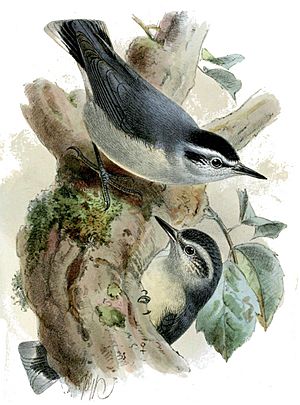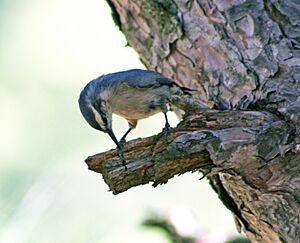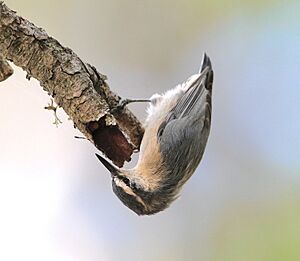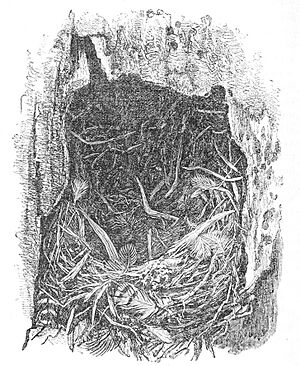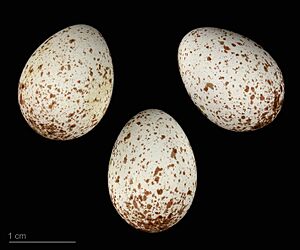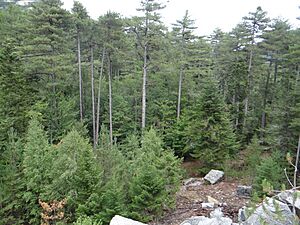Corsican nuthatch facts for kids
Quick facts for kids Corsican nuthatch |
|
|---|---|
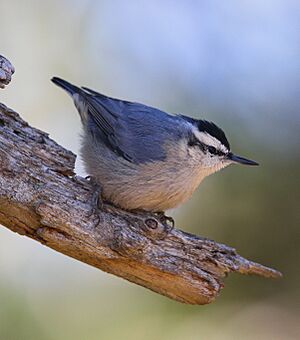 |
|
| Male | |
| Conservation status | |
| Scientific classification | |
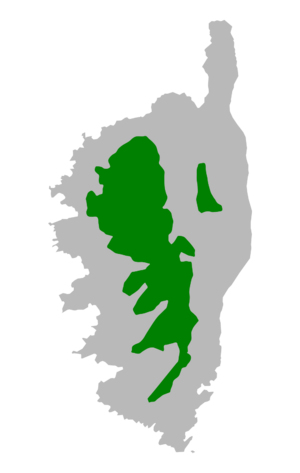 |
|
| Distribution of the Corsican nuthatch on the island, according to the International Union for Conservation of Nature. | |
| Synonyms | |
|
The Corsican nuthatch (Sitta whiteheadi) is a small bird found only on the island of Corsica. It belongs to the nuthatch family, known for birds that can climb trees head-first. This nuthatch is about 12 cm (4.7 in) long. Its back is bluish-gray, and its belly is grayish-white.
You can tell the male apart from the female because the male has a completely black head top (called a crown). These birds stay in Corsica all year round and defend their homes. They often look for food high up in Corsican pines. They mostly eat pine nuts but also catch flying insects.
The Corsican nuthatch builds its nest in old pine tree trunks. The female lays five to six eggs, usually in April or May. The young birds leave the nest about 22 to 24 days after hatching.
This special bird lives in old forests of high-altitude pine trees. Its scientific name honors John Whitehead, who first told scientists about it in 1883. The Corsican nuthatch is related to the Chinese nuthatch and the red-breasted nuthatch. Sadly, it is a "vulnerable" species. This means its numbers are dropping because it's losing its nesting places and its forest home is breaking apart. There are only about 2,000 Corsican nuthatches left.
Contents
How the Corsican Nuthatch Was Discovered
The Corsican nuthatch was first found by a bird watcher named John Whitehead. On June 13, 1883, he was in Corsica looking for other birds. He saw and collected a male Corsican nuthatch.
Whitehead later asked Richard Bowdler Sharpe, another bird expert, for help identifying some birds he had collected. Sharpe realized this nuthatch was a new species that no one had described before! Whitehead didn't share the exact spot where he found the bird at first. He worried that too many collectors would try to find it and harm the species.
Whitehead went back to Corsica in May 1884. He found more nuthatches and even located their nests. Some nests were very high up, about 30 m (1,200 in) (almost 100 feet) off the ground! He found five eggs in each nest he looked at.
Other scientists also observed this bird. An Italian expert, Enrico Hillyer Giglioli, saw it in 1877 but thought it was a common Eurasian nuthatch. Later, in the 1960s, a German bird expert named Hans Löhrl started studying how the Corsican nuthatch reproduces, eats, and behaves. Since the 1990s, local groups have been studying these birds closely to help protect them.
Its Name and Family Tree
Sharpe officially described the Corsican nuthatch in March 1884, giving it the name Sitta whiteheadi after John Whitehead. For a while, some scientists thought it was a type of red-breasted nuthatch. But later studies showed it was its own unique species.
Scientists use DNA studies to understand how different species are related. These studies show that the Corsican nuthatch is closely related to the Chinese nuthatch and the red-breasted nuthatch. These three species are like close cousins in the nuthatch family. They all share a special feature: only the males have a completely black head top.
Scientists believe these birds spread out from Asia a long time ago. The Corsican nuthatch might be a "paleoendemic" species. This means it might have lived in many places in the past but is now only found in Corsica. It got "trapped" there as pine forests changed over time.
What the Corsican Nuthatch Looks Like
The Corsican nuthatch is a small bird, about 11–12 cm (4.3–4.7 in) long. Its wings spread about 21–22 cm (8.3–8.7 in) wide, and it weighs around 11–12.6 grams (0.39–0.44 oz). It has a small head and a short, thin, blackish-gray beak. Its eyes are black, and its legs and toes are light brown.
The top part of its body is bluish-gray, and its belly is pale grayish-white.
- Males have a black head top and a black stripe through their eye. A bright white stripe sits above the eye stripe.
- Females have a gray head top and eye stripe, the same color as their back.
Both males and females have white cheeks and throats. Young birds look similar to adults but are a bit duller in color.
What the Corsican Nuthatch Sounds Like
The Corsican nuthatch makes a soft, whistling pu sound. It often repeats this sound in a series, like pupupupu. When it's upset, it might make a rough, drawn-out pchèèhr sound. It also has a clear, fast song that sounds like dididididi. It sings more often in the spring but is quieter during nesting season.
Birds That Look Similar
The Corsican nuthatch is the only nuthatch found in Corsica. However, it might look a bit like the coal tit, which also lives in Corsican forests. The coal tit has similar markings on its head.
Other nuthatches that look a bit like it live in different places:
- The Eurasian nuthatch (found in mainland France) is bigger and has no black on its head.
- The Chinese nuthatch has brighter colored underparts.
- Krüper's nuthatch is similar in size but has a reddish-brown patch on its belly.
- The red-breasted nuthatch (found in North America) has yellowish underparts.
- The Algerian nuthatch has paler underparts and a black patch only on the front of the male's head.
Where the Corsican Nuthatch Lives
The Corsican nuthatch is a special bird because it is the only bird species found only in Corsica. Its home is mostly in the mountainous areas of the island. You can find it from the Tartagine-Melaja forest in the north to the Ospedale forest in the south. It's especially common in the Monte Cinto and Monte Rotondo mountains.
This nuthatch loves old forests of Corsican pines (also called laricio pines). These forests are usually quite dry in summer but get a lot of rain at other times of the year. The bird stays in these forests all year. It usually lives in deep valleys between 1,000 m (39,000 in) and 1,500 m (59,000 in) above sea level. In winter, it might move to lower areas.
The Corsican nuthatch needs old, large pine trees to find food and nest. It avoids areas where trees are small or where there are too many other types of trees. The tough seeds of other pine types might be harder for them to eat.
How the Corsican Nuthatch Lives
Like all nuthatches, the Corsican nuthatch can climb down tree trunks head-first. It rarely spends time on the ground. These birds are not shy and like to stay in their own area. They live in pairs that stay together all year. Each pair defends its territory, which can be from three to ten hectares (about 7 to 25 acres). They chase away other nuthatches or even other bird species that come too close.
What the Corsican Nuthatch Eats
The Corsican nuthatch mainly eats pine nuts. But in summer, it also eats small flying insects. From March to November, it eats mostly small bugs like adult insects, their larvae, and spiders. It catches these bugs in the trees or sometimes even in the air.
In spring and summer, it often looks for food high up in the pine tree branches, like a chickadee. In autumn, it searches along tree trunks and large branches. Sometimes, it joins other small birds to look for food outside of nesting season.
In November, pine cones start to open. The nuthatch uses its thin beak to get the seeds out. If there are lots of cones, they can find food until March. Like other nuthatches, they also hide seeds under bark or moss. They eat these hidden seeds later, especially when snow covers the cones or when it's too cold and wet for cones to open. Hiding food helps them stay in their territory all year.
Reproduction and Life Cycle
Male Corsican nuthatches start singing in late December. But the main nesting season is in April and May. If there are lots of pine cones, they might start nesting earlier. If food is scarce, they wait until more insects are available.
These birds need very old pine trees, two to three hundred years old, for nesting. They look for trees with soft, dead, or rotting trunks. Both the male and female help dig out the nest hole. They often use old holes made by great spotted woodpeckers.
The nest entrance is about 3–4 cm (1.2–1.6 in) wide. The nest itself is about 12 cm (4.7 in) deep. Nests can be anywhere from 2–30 m (79–1,181 in) above the ground. They build the nest with pine needles, bark, and wood shavings. They line it with soft materials like feathers, moss, or horsehair.
The female lays four to six (usually five) white eggs with reddish-brown spots. The eggs are similar in size to those of a great tit. The female sits on the eggs for 14 to 17 days. The male brings her food during this time.
The young birds usually leave the nest when they are 22 to 24 days old. If a first nest fails, the pair might try to nest again in late May or early June. About half of the pairs change trees for nesting each year. Young nuthatches can start breeding when they are one year old. Some Corsican nuthatches have been known to live up to six years.
Threats and Conservation
Numbers and Status
In the 1950s, there were about 3,000 pairs of Corsican nuthatches. By the 2000s, estimates showed around 2,075 to 3,010 pairs. More recent numbers from 2013 suggest there are about 3,100 to 4,400 adult birds in total.
The International Union for Conservation of Nature (IUCN) first listed the Corsican nuthatch as "near threatened" in 1988. Then it was "least concern" for a few years. But since 2010, it has been listed as "vulnerable". This means its population is decreasing, with an estimated 10% drop in ten years.
Threats to the Corsican Nuthatch
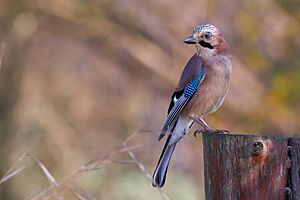
The main reasons for the decline in nuthatch numbers are forest fires and logging. The old Corsican pines they need are disappearing faster than new ones can grow. Cutting down dead pines is a big problem because these are the trees they use for nesting. After a fire, other trees like maritime pines or holm oaks might grow instead of the laricio pines the nuthatches prefer. Fires in 2000 and 2003 caused a big drop in the nuthatch population, with some areas losing many territories.
Other animals also pose a threat:
- The great spotted woodpecker can attack nuthatch nests and young birds by making the nest hole bigger.
- The garden dormouse might also eat young nuthatches.
- Birds of prey like the Eurasian sparrowhawk might hunt nuthatches.
- The Eurasian jay might also eat young nuthatches.
Another problem is that the forests where they live are becoming "fragmented." This means their habitat is broken up into smaller pieces. Nuthatches don't like to cross open areas or young tree plantations because it's riskier for them. This can make it harder for different groups of nuthatches to connect.
Scientists have also looked at how climate change might affect the Corsican nuthatch. While climate change could expand their habitat slightly, the biggest threats are still the increase in fires and human activities.
Protecting the Corsican Nuthatch
The Corsican nuthatch is fully protected in France. It is against the law to harm, capture, or disturb these birds. It's also forbidden to destroy their eggs, nests, or their forest home. You cannot transport, sell, or buy them, whether they are alive or dead.
Many Corsican nuthatches live in special protected areas. These areas are managed to help the species survive. Protecting the forests from fires is a top priority. Also, forestry workers are encouraged to use methods that help keep the nuthatch's habitat healthy. This includes making sure there are enough old trees for nesting.
The Corsican Nuthatch in Culture
The Corsican nuthatch is sometimes called Whitehead's nuthatch. In the Corsican language, it has several local names, like pichjarina, pichja sorda, furmicula, and capinera.
Even though it's a special bird, many people don't know about it. The regional natural park of Corsica has made a small comic book about the bird. The "Corsican ornithological group" (GOC) even uses the nuthatch as its logo! In the Aïtone forest, there's a "nuthatch trail" created by the National Forestry Office. This trail is one of the best places to try and spot this unique bird.



